
all-rag-techniques
Implementation of all RAG techniques in a simpler way
Stars: 504
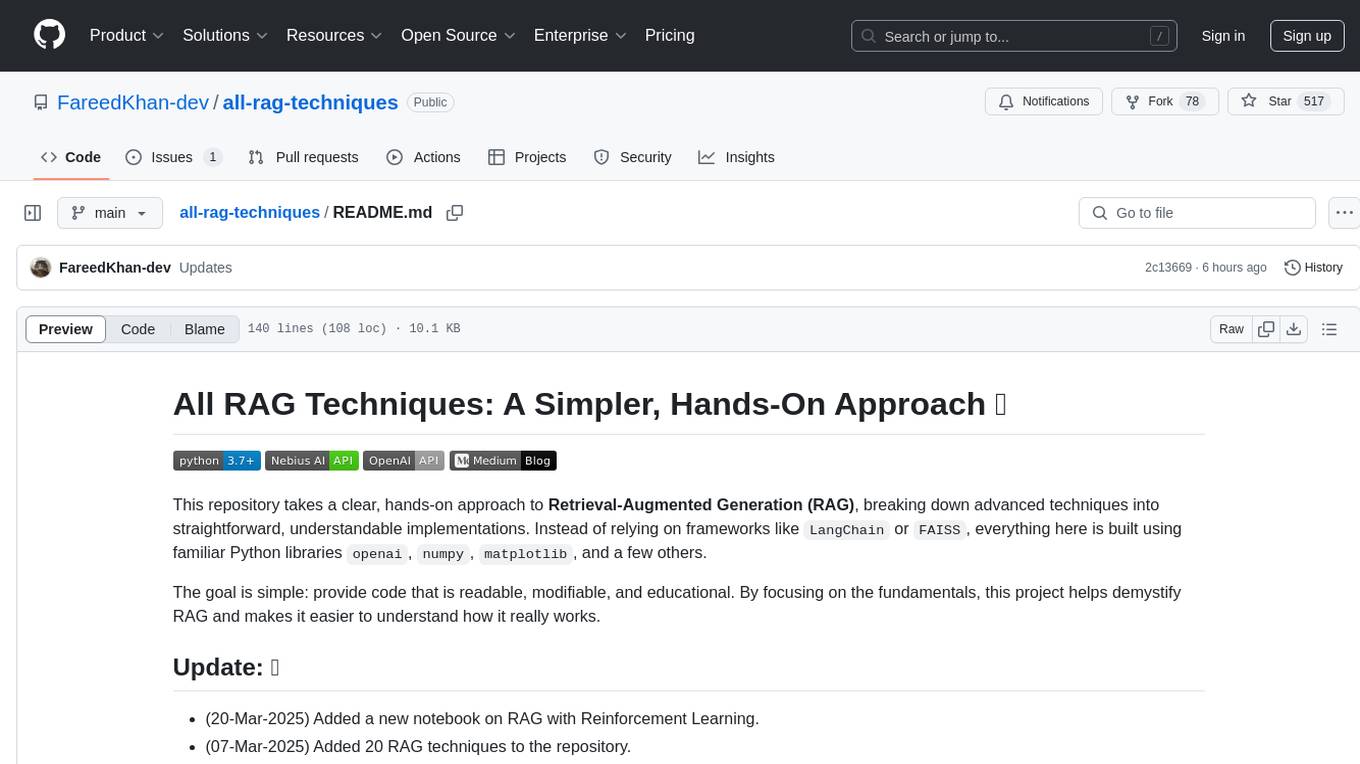
This repository provides a hands-on approach to Retrieval-Augmented Generation (RAG) techniques, simplifying advanced concepts into understandable implementations using Python libraries like openai, numpy, and matplotlib. It offers a collection of Jupyter Notebooks with concise explanations, step-by-step implementations, code examples, evaluations, and visualizations for various RAG techniques. The goal is to make RAG more accessible and demystify its workings for educational purposes.
README:
This repository takes a clear, hands-on approach to Retrieval-Augmented Generation (RAG), breaking down advanced techniques into straightforward, understandable implementations. Instead of relying on frameworks like LangChain or FAISS, everything here is built using familiar Python libraries openai, numpy, matplotlib, and a few others.
The goal is simple: provide code that is readable, modifiable, and educational. By focusing on the fundamentals, this project helps demystify RAG and makes it easier to understand how it really works.
- (20-Mar-2025) Added a new notebook on RAG with Reinforcement Learning.
- (07-Mar-2025) Added 20 RAG techniques to the repository.
This repository contains a collection of Jupyter Notebooks, each focusing on a specific RAG technique. Each notebook provides:
- A concise explanation of the technique.
- A step-by-step implementation from scratch.
- Clear code examples with inline comments.
- Evaluations and comparisons to demonstrate the technique's effectiveness.
- Visualization to visualize the results.
Here's a glimpse of the techniques covered:
| Notebook | Description |
|---|---|
| 1. Simple RAG | A basic RAG implementation. A great starting point! |
| 2. Semantic Chunking | Splits text based on semantic similarity for more meaningful chunks. |
| 3. Chunk Size Selector | Explores the impact of different chunk sizes on retrieval performance. |
| 4. Context Enriched RAG | Retrieves neighboring chunks to provide more context. |
| 5. Contextual Chunk Headers | Prepends descriptive headers to each chunk before embedding. |
| 6. Document Augmentation RAG | Generates questions from text chunks to augment the retrieval process. |
| 7. Query Transform | Rewrites, expands, or decomposes queries to improve retrieval. Includes Step-back Prompting and Sub-query Decomposition. |
| 8. Reranker | Re-ranks initially retrieved results using an LLM for better relevance. |
| 9. RSE | Relevant Segment Extraction: Identifies and reconstructs continuous segments of text, preserving context. |
| 10. Contextual Compression | Implements contextual compression to filter and compress retrieved chunks, maximizing relevant information. |
| 11. Feedback Loop RAG | Incorporates user feedback to learn and improve RAG system over time. |
| 12. Adaptive RAG | Dynamically selects the best retrieval strategy based on query type. |
| 13. Self RAG | Implements Self-RAG, dynamically decides when and how to retrieve, evaluates relevance, and assesses support and utility. |
| 14. Proposition Chunking | Breaks down documents into atomic, factual statements for precise retrieval. |
| 15. Multimodel RAG | Combines text and images for retrieval, generating captions for images using LLaVA. |
| 16. Fusion RAG | Combines vector search with keyword-based (BM25) retrieval for improved results. |
| 17. Graph RAG | Organizes knowledge as a graph, enabling traversal of related concepts. |
| 18. Hierarchy RAG | Builds hierarchical indices (summaries + detailed chunks) for efficient retrieval. |
| 19. HyDE RAG | Uses Hypothetical Document Embeddings to improve semantic matching. |
| 20. CRAG | Corrective RAG: Dynamically evaluates retrieval quality and uses web search as a fallback. |
| 21. Rag with RL | Maximize the reward of the RAG model using Reinforcement Learning. |
fareedkhan-dev-all-rag-techniques/
├── README.md <- You are here!
├── 1_simple_rag.ipynb
├── 2_semantic_chunking.ipynb
├── 3_chunk_size_selector.ipynb
├── 4_context_enriched_rag.ipynb
├── 5_contextual_chunk_headers_rag.ipynb
├── 6_doc_augmentation_rag.ipynb
├── 7_query_transform.ipynb
├── 8_reranker.ipynb
├── 9_rse.ipynb
├── 10_contextual_compression.ipynb
├── 11_feedback_loop_rag.ipynb
├── 12_adaptive_rag.ipynb
├── 13_self_rag.ipynb
├── 14_proposition_chunking.ipynb
├── 15_multimodel_rag.ipynb
├── 16_fusion_rag.ipynb
├── 17_graph_rag.ipynb
├── 18_hierarchy_rag.ipynb
├── 19_HyDE_rag.ipynb
├── 20_crag.ipynb
├── 21_rag_with_rl.ipynb
├── requirements.txt <- Python dependencies
└── data/
└── val.json <- Sample validation data (queries and answers)
└── AI_information.pdf <- A sample PDF document for testing.
└── attention_is_all_you_need.pdf <- A sample PDF document for testing (for Multi-Modal RAG).
-
Clone the repository:
git clone https://github.com/FareedKhan-dev/all-rag-techniques.git cd all-rag-techniques -
Install dependencies:
pip install -r requirements.txt
-
Set up your OpenAI API key:
-
Obtain an API key from Nebius AI.
-
Set the API key as an environment variable:
export OPENAI_API_KEY='YOUR_NEBIUS_AI_API_KEY'
or
setx OPENAI_API_KEY "YOUR_NEBIUS_AI_API_KEY" # On Windows
or, within your Python script/notebook:
import os os.environ["OPENAI_API_KEY"] = "YOUR_NEBIUS_AI_API_KEY"
-
-
Run the notebooks:
Open any of the Jupyter Notebooks (
.ipynbfiles) using Jupyter Notebook or JupyterLab. Each notebook is self-contained and can be run independently. The notebooks are designed to be executed sequentially within each file.Note: The
data/AI_information.pdffile provides a sample document for testing. You can replace it with your own PDF. Thedata/val.jsonfile contains sample queries and ideal answers for evaluation. The 'attention_is_all_you_need.pdf' is for testing Multi-Modal RAG Notebook.
-
Embeddings: Numerical representations of text that capture semantic meaning. We use Nebius AI's embedding API and, in many notebooks, also the
BAAI/bge-en-iclembedding model. -
Vector Store: A simple database to store and search embeddings. We create our own
SimpleVectorStoreclass using NumPy for efficient similarity calculations. -
Cosine Similarity: A measure of similarity between two vectors. Higher values indicate greater similarity.
-
Chunking: Dividing text into smaller, manageable pieces. We explore various chunking strategies.
-
Retrieval: The process of finding the most relevant text chunks for a given query.
-
Generation: Using a Large Language Model (LLM) to create a response based on the retrieved context and the user's query. We use the
meta-llama/Llama-3.2-3B-Instructmodel via Nebius AI's API. -
Evaluation: Assessing the quality of the RAG system's responses, often by comparing them to a reference answer or using an LLM to score relevance.
Contributions are welcome!
For Tasks:
Click tags to check more tools for each tasksFor Jobs:
Alternative AI tools for all-rag-techniques
Similar Open Source Tools

all-rag-techniques
This repository provides a hands-on approach to Retrieval-Augmented Generation (RAG) techniques, simplifying advanced concepts into understandable implementations using Python libraries like openai, numpy, and matplotlib. It offers a collection of Jupyter Notebooks with concise explanations, step-by-step implementations, code examples, evaluations, and visualizations for various RAG techniques. The goal is to make RAG more accessible and demystify its workings for educational purposes.
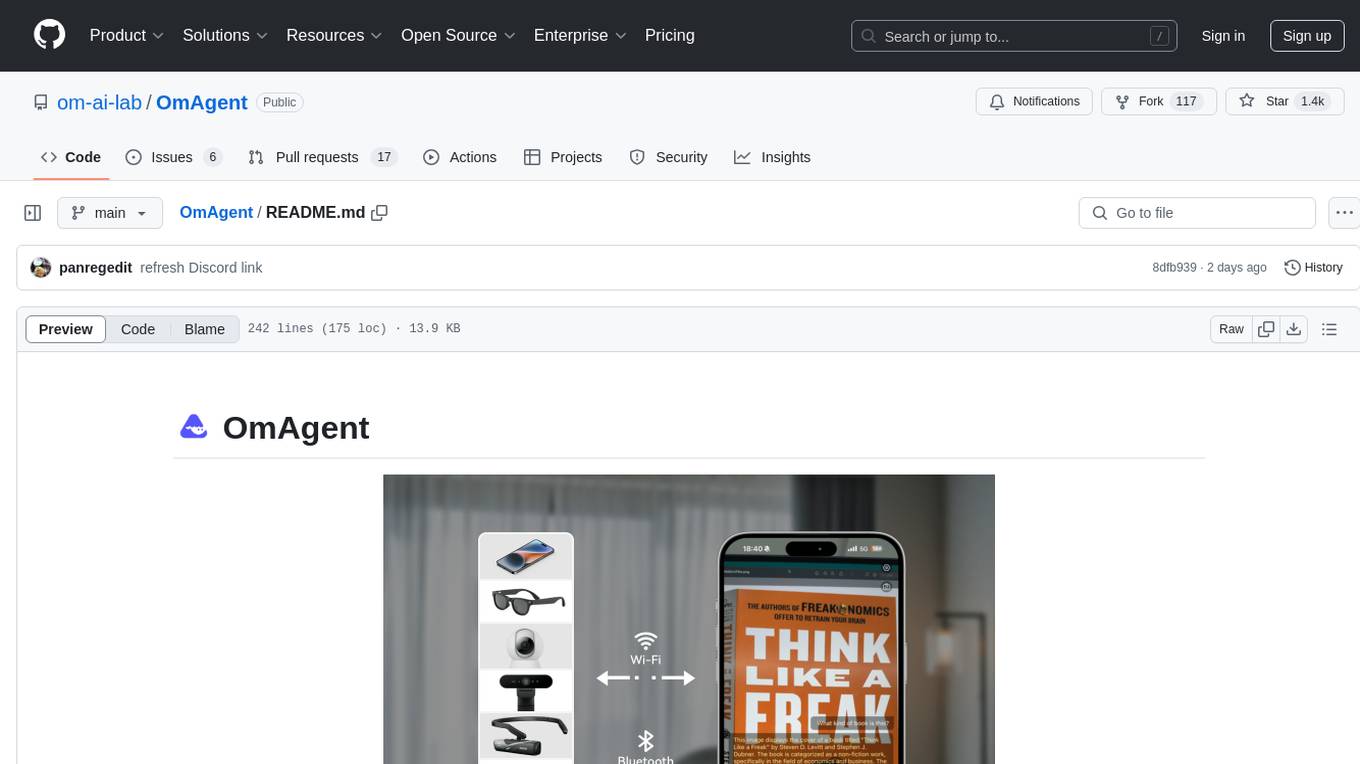
OmAgent
OmAgent is an open-source agent framework designed to streamline the development of on-device multimodal agents. It enables agents to empower various hardware devices, integrates speed-optimized SOTA multimodal models, provides SOTA multimodal agent algorithms, and focuses on optimizing the end-to-end computing pipeline for real-time user interaction experience. Key features include easy connection to diverse devices, scalability, flexibility, and workflow orchestration. The architecture emphasizes graph-based workflow orchestration, native multimodality, and device-centricity, allowing developers to create bespoke intelligent agent programs.
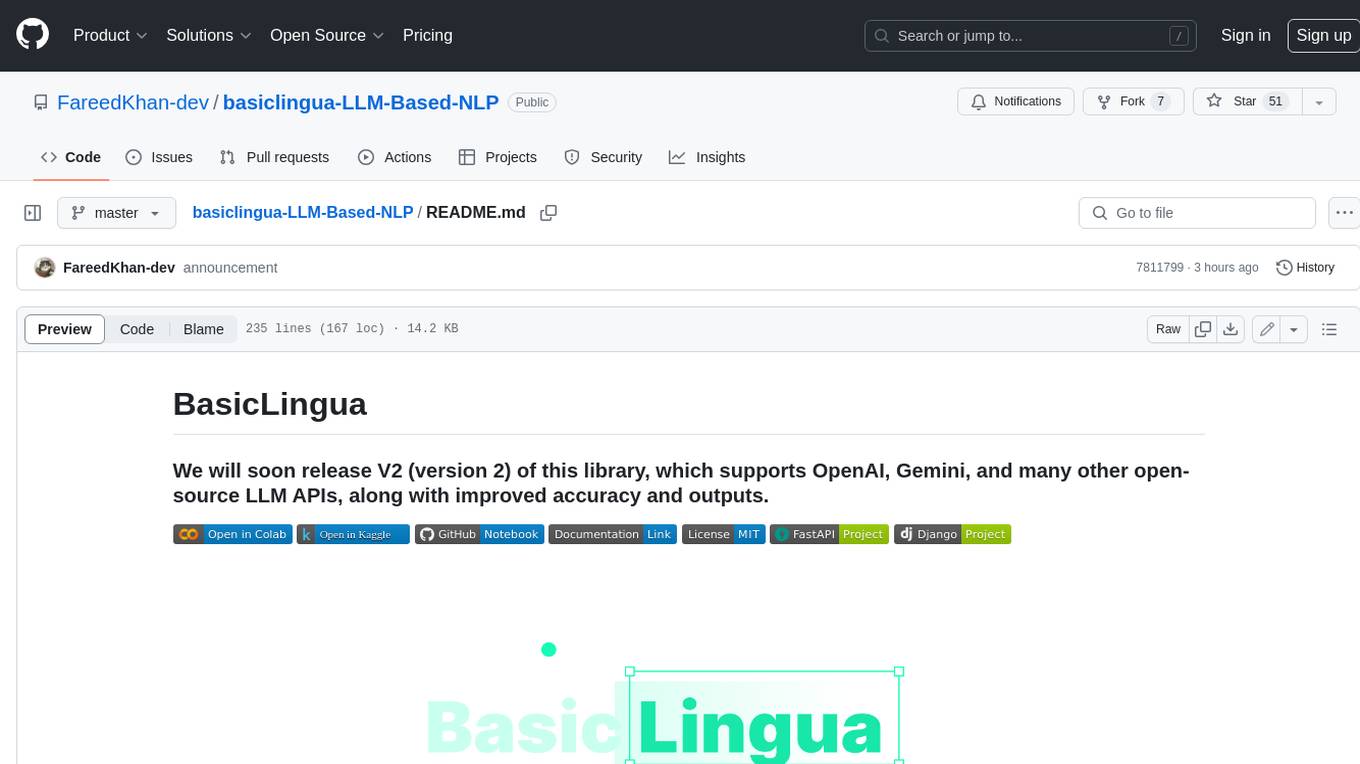
basiclingua-LLM-Based-NLP
BasicLingua is a Python library that provides functionalities for linguistic tasks such as tokenization, stemming, lemmatization, and many others. It is based on the Gemini Language Model, which has demonstrated promising results in dealing with text data. BasicLingua can be used as an API or through a web demo. It is available under the MIT license and can be used in various projects.
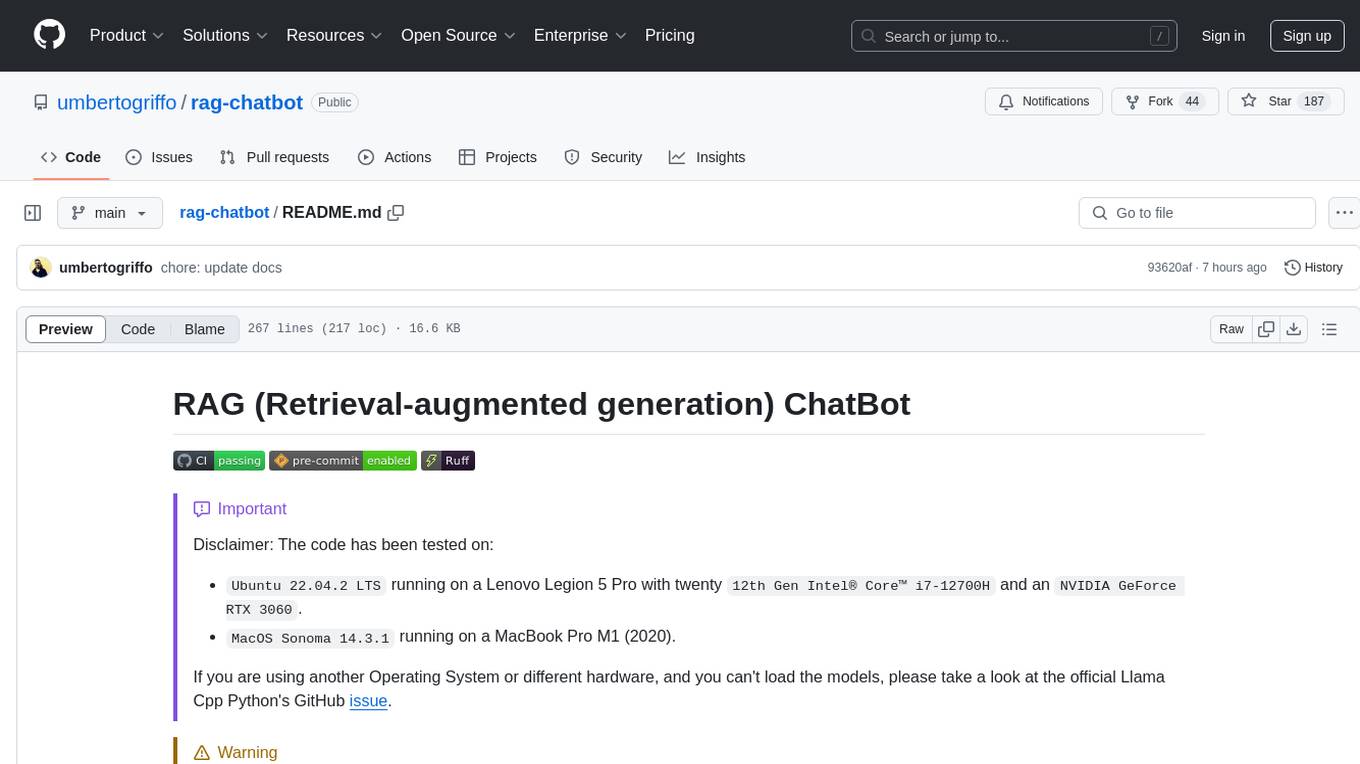
rag-chatbot
The RAG ChatBot project combines Lama.cpp, Chroma, and Streamlit to build a Conversation-aware Chatbot and a Retrieval-augmented generation (RAG) ChatBot. The RAG Chatbot works by taking a collection of Markdown files as input and provides answers based on the context provided by those files. It utilizes a Memory Builder component to load Markdown pages, divide them into sections, calculate embeddings, and save them in an embedding database. The chatbot retrieves relevant sections from the database, rewrites questions for optimal retrieval, and generates answers using a local language model. It also remembers previous interactions for more accurate responses. Various strategies are implemented to deal with context overflows, including creating and refining context, hierarchical summarization, and async hierarchical summarization.
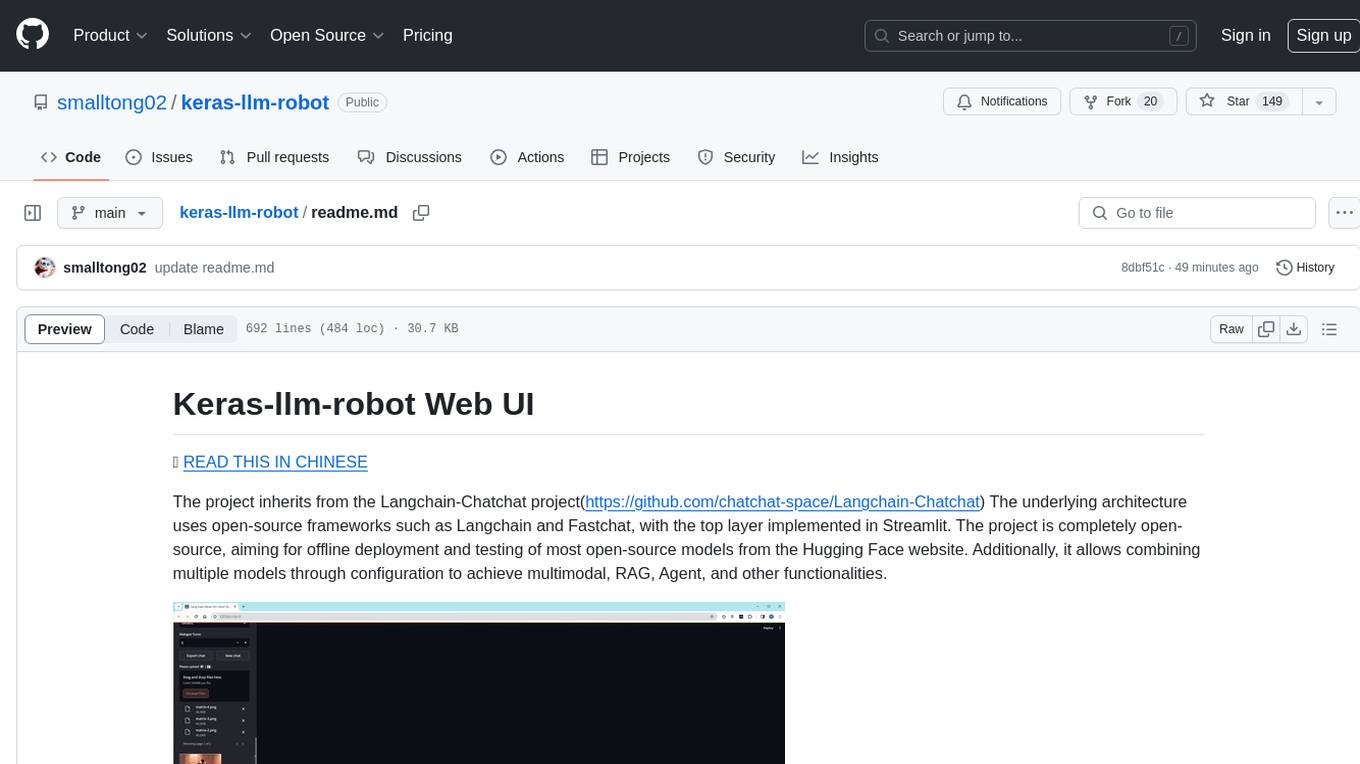
keras-llm-robot
The Keras-llm-robot Web UI project is an open-source tool designed for offline deployment and testing of various open-source models from the Hugging Face website. It allows users to combine multiple models through configuration to achieve functionalities like multimodal, RAG, Agent, and more. The project consists of three main interfaces: chat interface for language models, configuration interface for loading models, and tools & agent interface for auxiliary models. Users can interact with the language model through text, voice, and image inputs, and the tool supports features like model loading, quantization, fine-tuning, role-playing, code interpretation, speech recognition, image recognition, network search engine, and function calling.
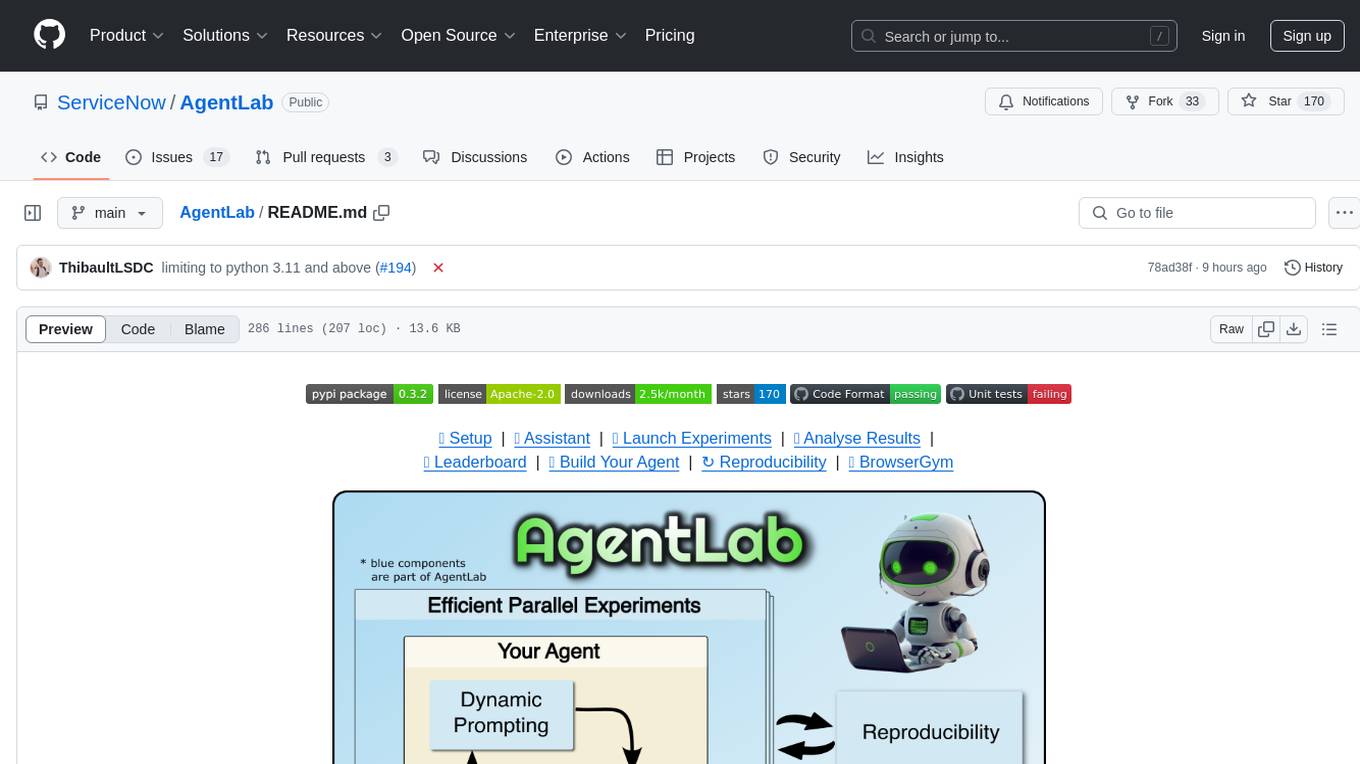
AgentLab
AgentLab is an open, easy-to-use, and extensible framework designed to accelerate web agent research. It provides features for developing and evaluating agents on various benchmarks supported by BrowserGym. The framework allows for large-scale parallel agent experiments using ray, building blocks for creating agents over BrowserGym, and a unified LLM API for OpenRouter, OpenAI, Azure, or self-hosted using TGI. AgentLab also offers reproducibility features, a unified LeaderBoard, and supports multiple benchmarks like WebArena, WorkArena, WebLinx, VisualWebArena, AssistantBench, GAIA, Mind2Web-live, and MiniWoB.
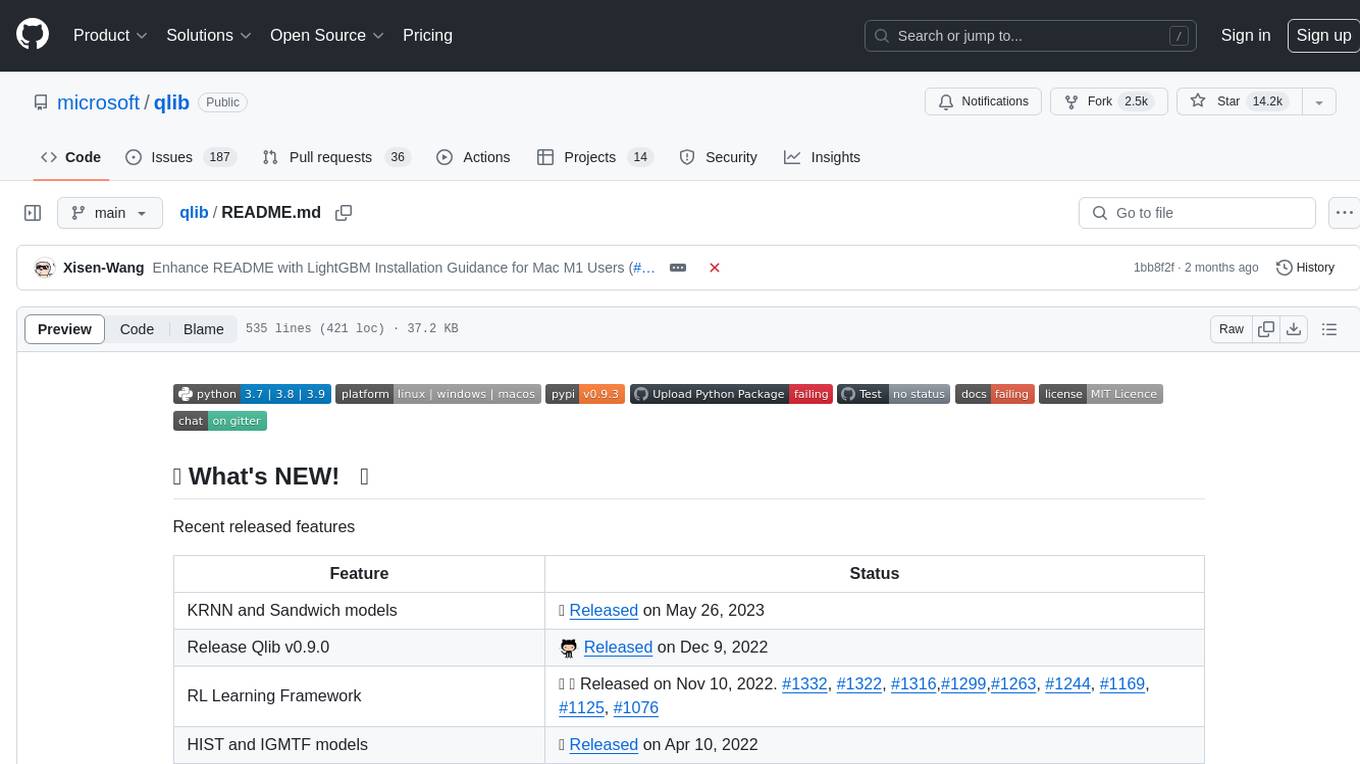
qlib
Qlib is an open-source, AI-oriented quantitative investment platform that supports diverse machine learning modeling paradigms, including supervised learning, market dynamics modeling, and reinforcement learning. It covers the entire chain of quantitative investment, from alpha seeking to order execution. The platform empowers researchers to explore ideas and implement productions using AI technologies in quantitative investment. Qlib collaboratively solves key challenges in quantitative investment by releasing state-of-the-art research works in various paradigms. It provides a full ML pipeline for data processing, model training, and back-testing, enabling users to perform tasks such as forecasting market patterns, adapting to market dynamics, and modeling continuous investment decisions.
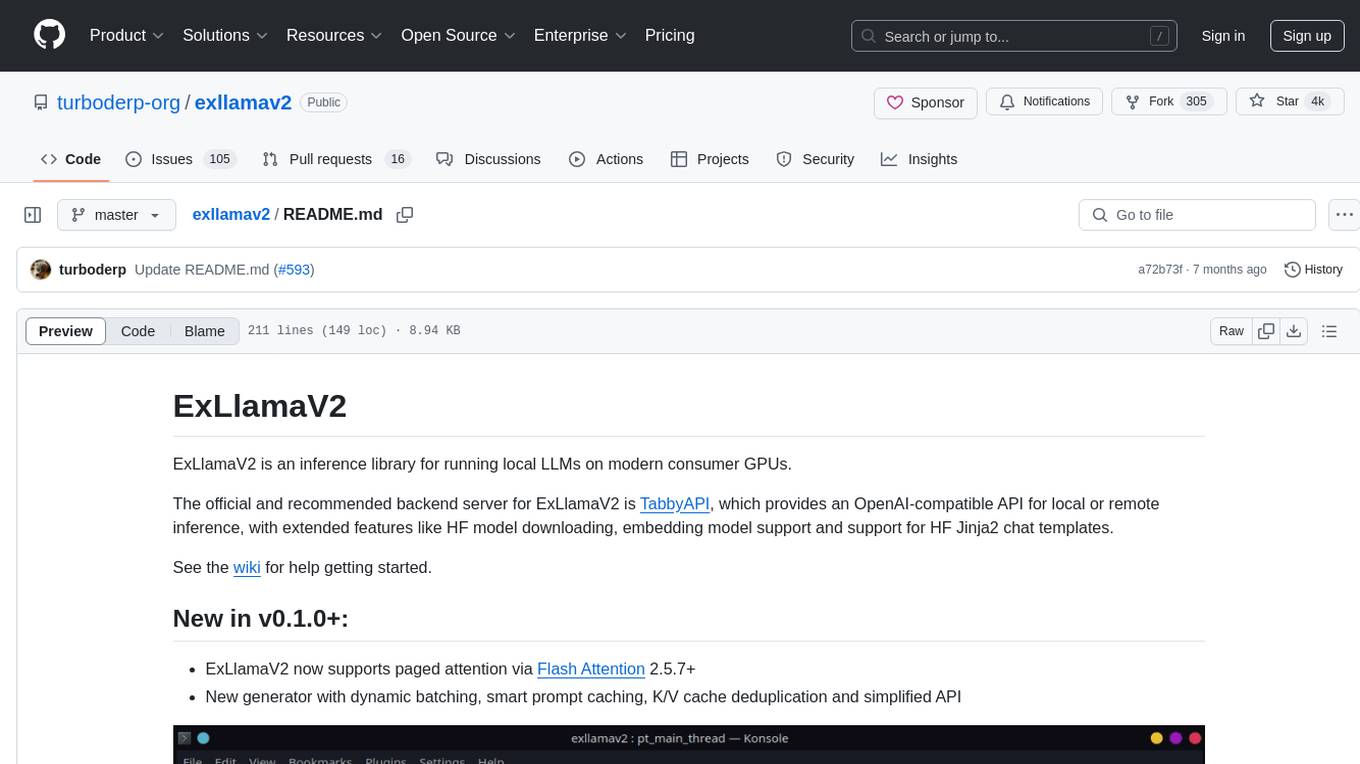
exllamav2
ExLlamaV2 is an inference library designed for running local LLMs on modern consumer GPUs. The library supports paged attention via Flash Attention 2.5.7+, offers a new dynamic generator with features like dynamic batching, smart prompt caching, and K/V cache deduplication. It also provides an API for local or remote inference using TabbyAPI, with extended features like HF model downloading and support for HF Jinja2 chat templates. ExLlamaV2 aims to optimize performance and speed across different GPU models, with potential future optimizations and variations in speeds. The tool can be integrated with TabbyAPI for OpenAI-style web API compatibility and supports a standalone web UI called ExUI for single-user interaction with chat and notebook modes. ExLlamaV2 also offers support for text-generation-webui and lollms-webui through specific loaders and bindings.
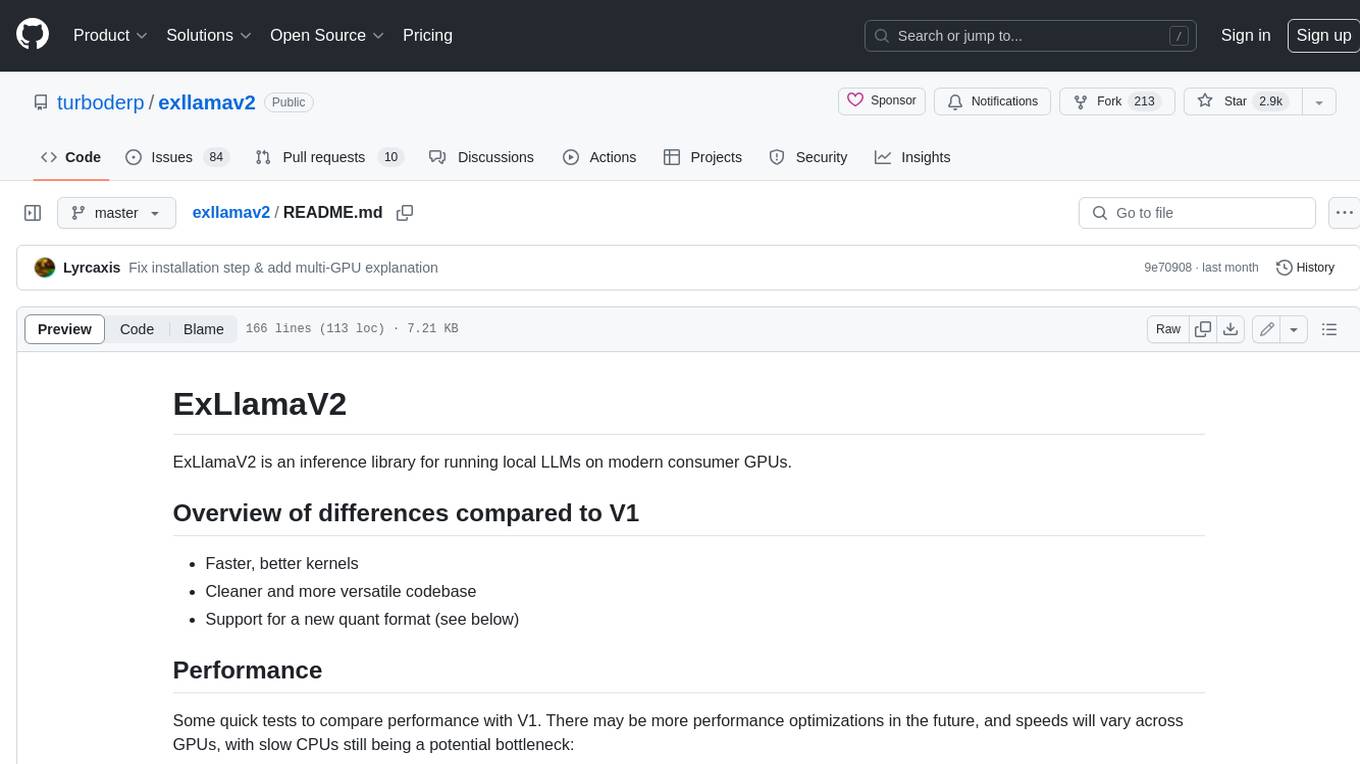
exllamav2
ExLlamaV2 is an inference library for running local LLMs on modern consumer GPUs. It is a faster, better, and more versatile codebase than its predecessor, ExLlamaV1, with support for a new quant format called EXL2. EXL2 is based on the same optimization method as GPTQ and supports 2, 3, 4, 5, 6, and 8-bit quantization. It allows for mixing quantization levels within a model to achieve any average bitrate between 2 and 8 bits per weight. ExLlamaV2 can be installed from source, from a release with prebuilt extension, or from PyPI. It supports integration with TabbyAPI, ExUI, text-generation-webui, and lollms-webui. Key features of ExLlamaV2 include: - Faster and better kernels - Cleaner and more versatile codebase - Support for EXL2 quantization format - Integration with various web UIs and APIs - Community support on Discord
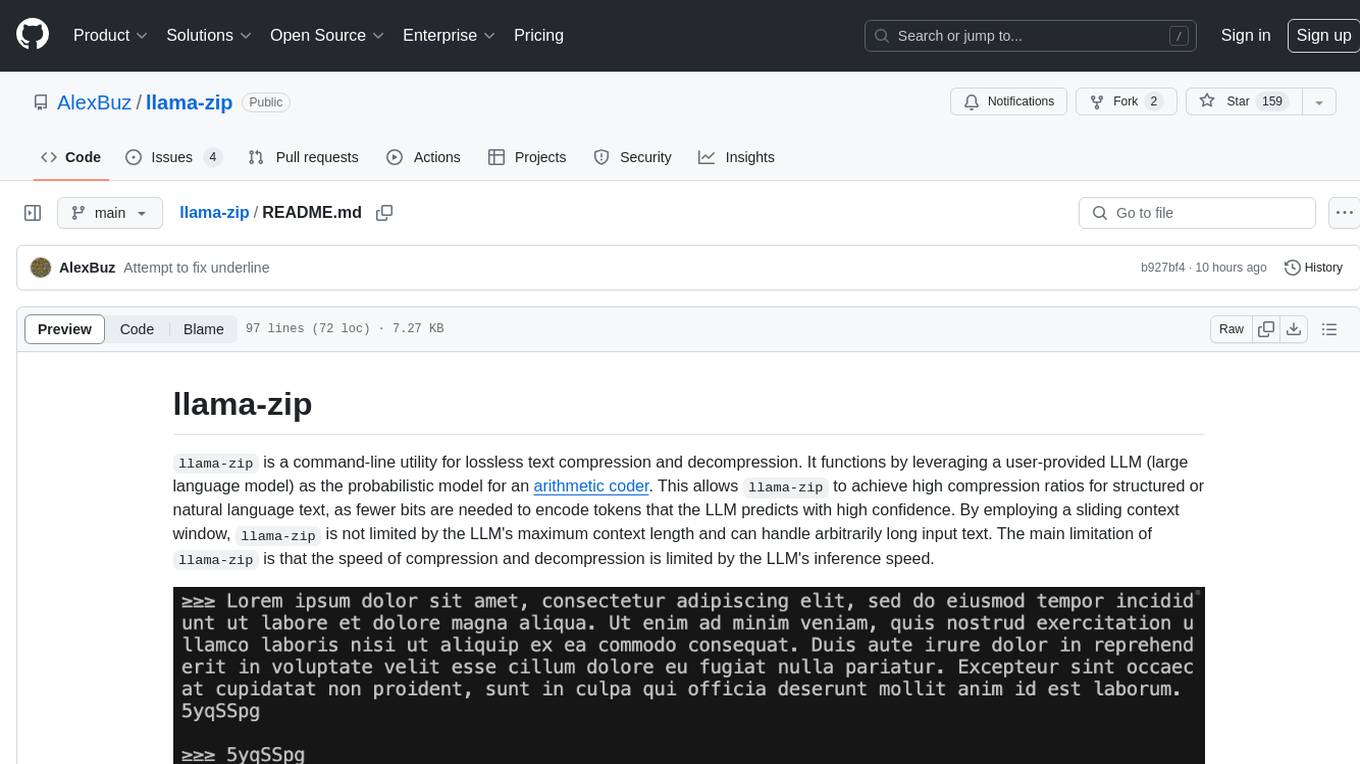
llama-zip
llama-zip is a command-line utility for lossless text compression and decompression. It leverages a user-provided large language model (LLM) as the probabilistic model for an arithmetic coder, achieving high compression ratios for structured or natural language text. The tool is not limited by the LLM's maximum context length and can handle arbitrarily long input text. However, the speed of compression and decompression is limited by the LLM's inference speed.
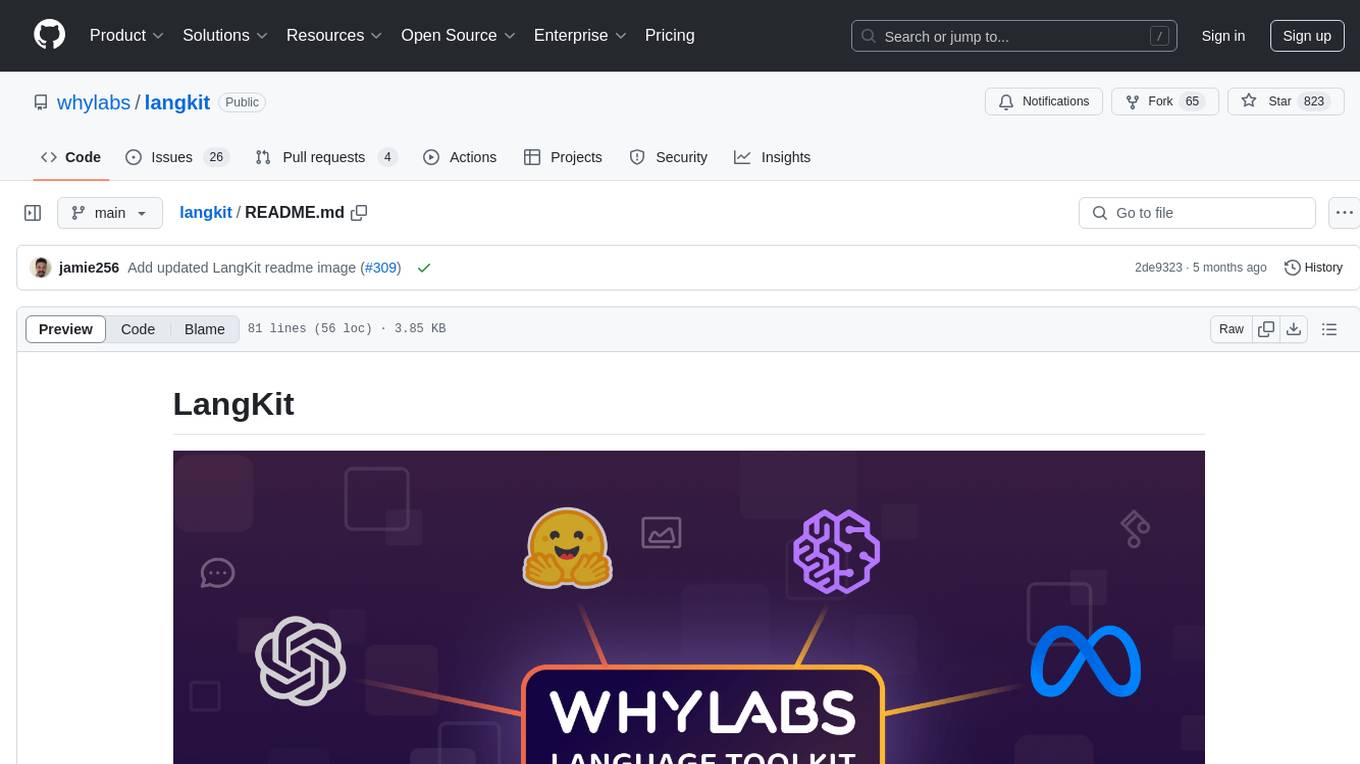
langkit
LangKit is an open-source text metrics toolkit for monitoring language models. It offers methods for extracting signals from input/output text, compatible with whylogs. Features include text quality, relevance, security, sentiment, toxicity analysis. Installation via PyPI. Modules contain UDFs for whylogs. Benchmarks show throughput on AWS instances. FAQs available.
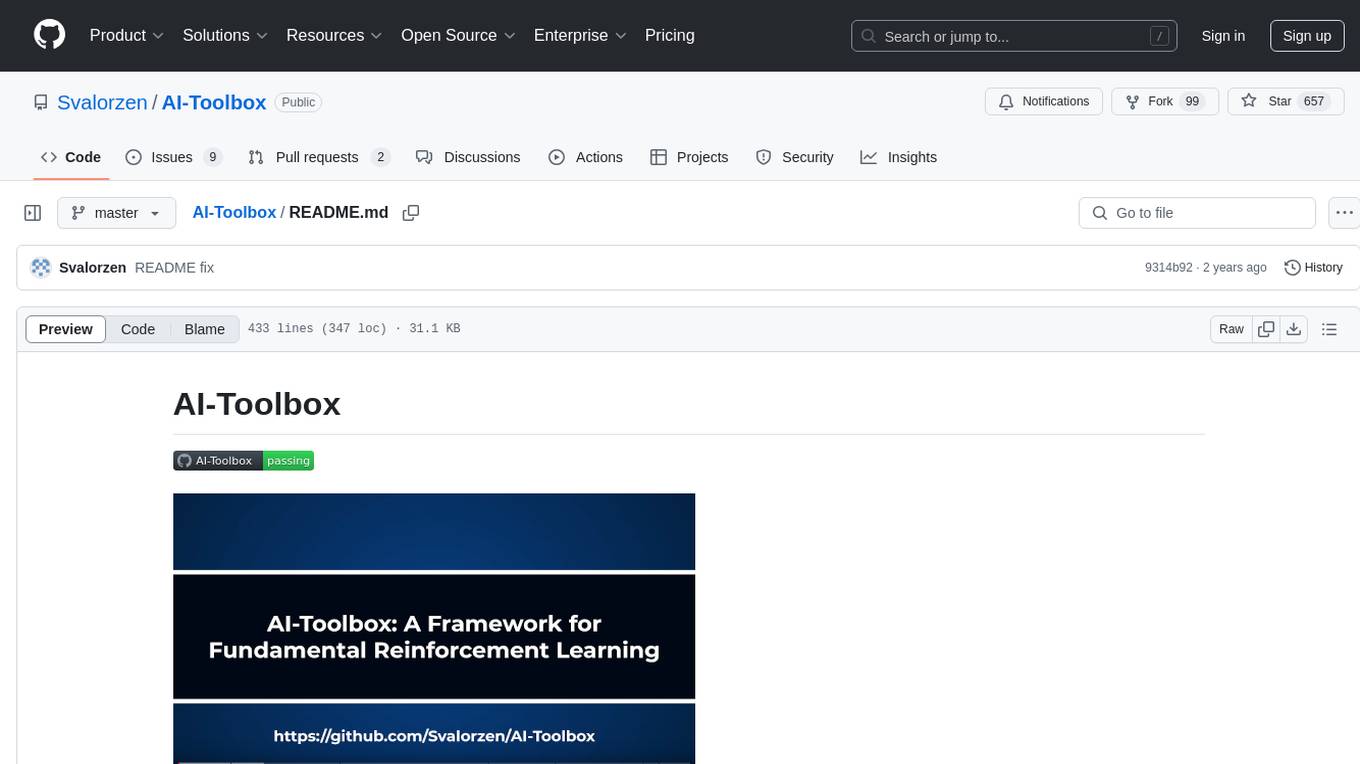
AI-Toolbox
AI-Toolbox is a C++ library aimed at representing and solving common AI problems, with a focus on MDPs, POMDPs, and related algorithms. It provides an easy-to-use interface that is extensible to many problems while maintaining readable code. The toolbox includes tutorials for beginners in reinforcement learning and offers Python bindings for seamless integration. It features utilities for combinatorics, polytopes, linear programming, sampling, distributions, statistics, belief updating, data structures, logging, seeding, and more. Additionally, it supports bandit/normal games, single agent MDP/stochastic games, single agent POMDP, and factored/joint multi-agent scenarios.
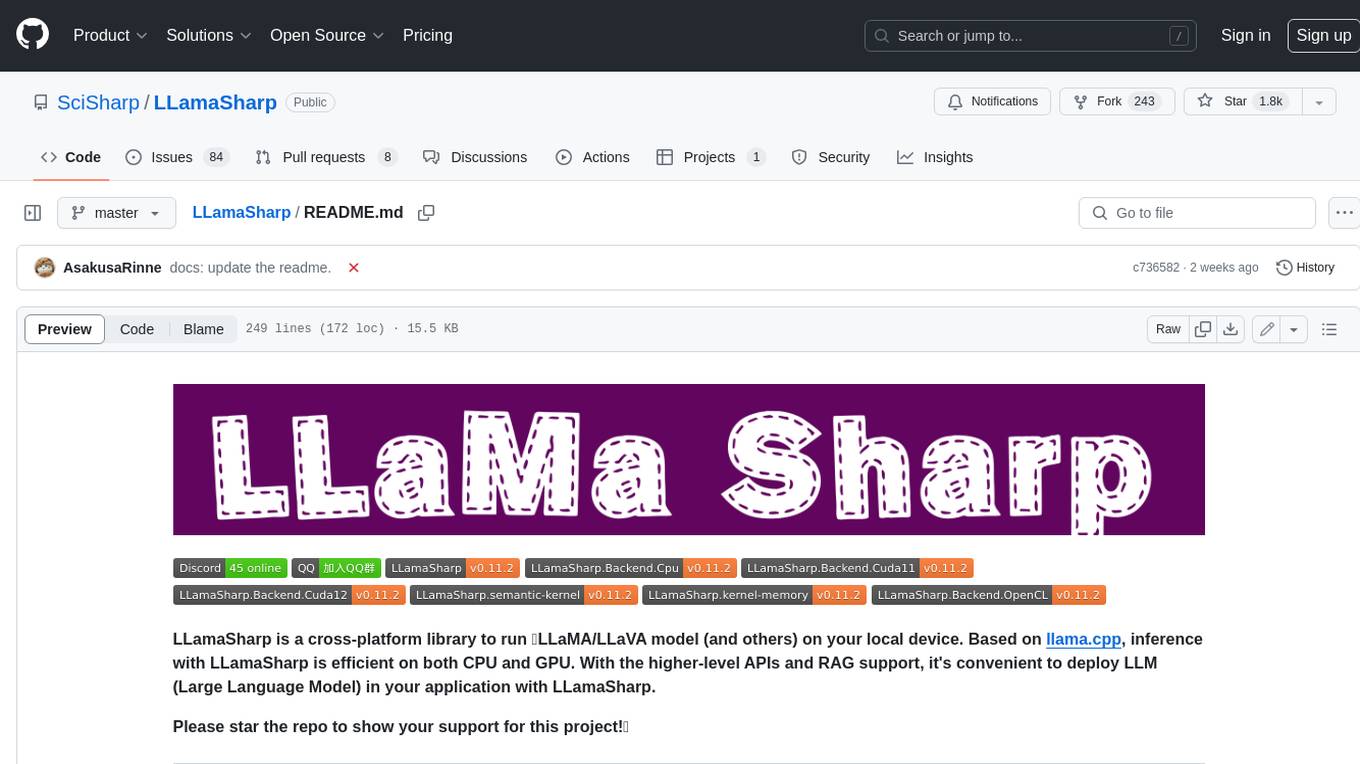
LLamaSharp
LLamaSharp is a cross-platform library to run 🦙LLaMA/LLaVA model (and others) on your local device. Based on llama.cpp, inference with LLamaSharp is efficient on both CPU and GPU. With the higher-level APIs and RAG support, it's convenient to deploy LLM (Large Language Model) in your application with LLamaSharp.
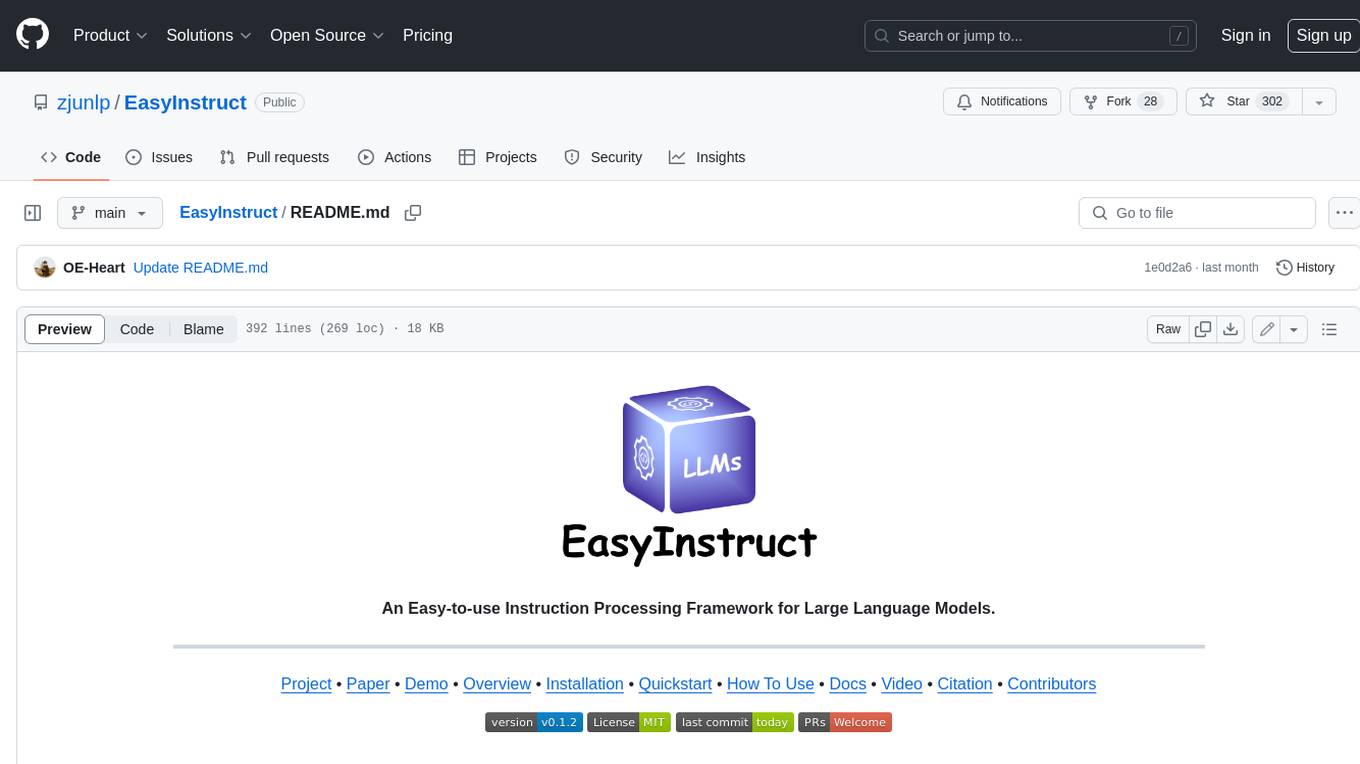
EasyInstruct
EasyInstruct is a Python package proposed as an easy-to-use instruction processing framework for Large Language Models (LLMs) like GPT-4, LLaMA, ChatGLM in your research experiments. EasyInstruct modularizes instruction generation, selection, and prompting, while also considering their combination and interaction.
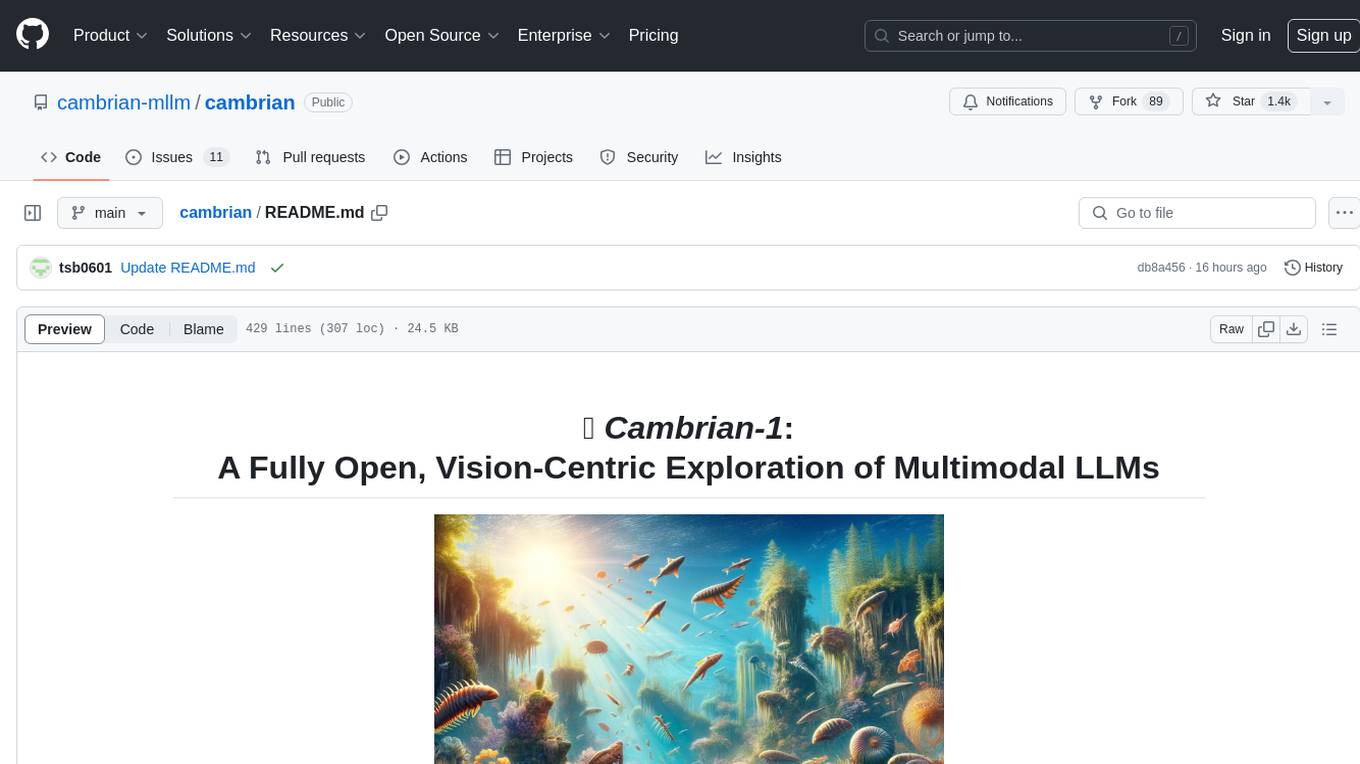
cambrian
Cambrian-1 is a fully open project focused on exploring multimodal Large Language Models (LLMs) with a vision-centric approach. It offers competitive performance across various benchmarks with models at different parameter levels. The project includes training configurations, model weights, instruction tuning data, and evaluation details. Users can interact with Cambrian-1 through a Gradio web interface for inference. The project is inspired by LLaVA and incorporates contributions from Vicuna, LLaMA, and Yi. Cambrian-1 is licensed under Apache 2.0 and utilizes datasets and checkpoints subject to their respective original licenses.
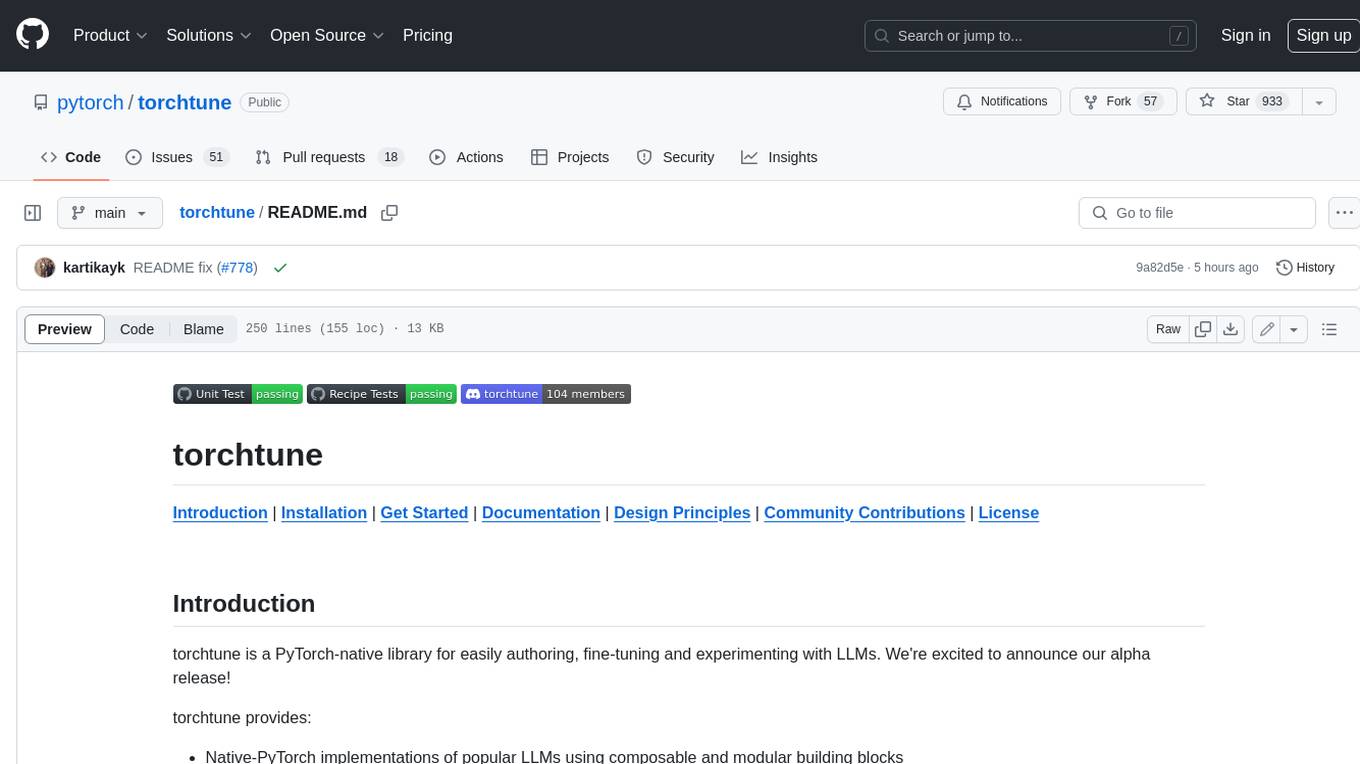
torchtune
Torchtune is a PyTorch-native library for easily authoring, fine-tuning, and experimenting with LLMs. It provides native-PyTorch implementations of popular LLMs using composable and modular building blocks, easy-to-use and hackable training recipes for popular fine-tuning techniques, YAML configs for easily configuring training, evaluation, quantization, or inference recipes, and built-in support for many popular dataset formats and prompt templates to help you quickly get started with training.
For similar tasks

all-rag-techniques
This repository provides a hands-on approach to Retrieval-Augmented Generation (RAG) techniques, simplifying advanced concepts into understandable implementations using Python libraries like openai, numpy, and matplotlib. It offers a collection of Jupyter Notebooks with concise explanations, step-by-step implementations, code examples, evaluations, and visualizations for various RAG techniques. The goal is to make RAG more accessible and demystify its workings for educational purposes.
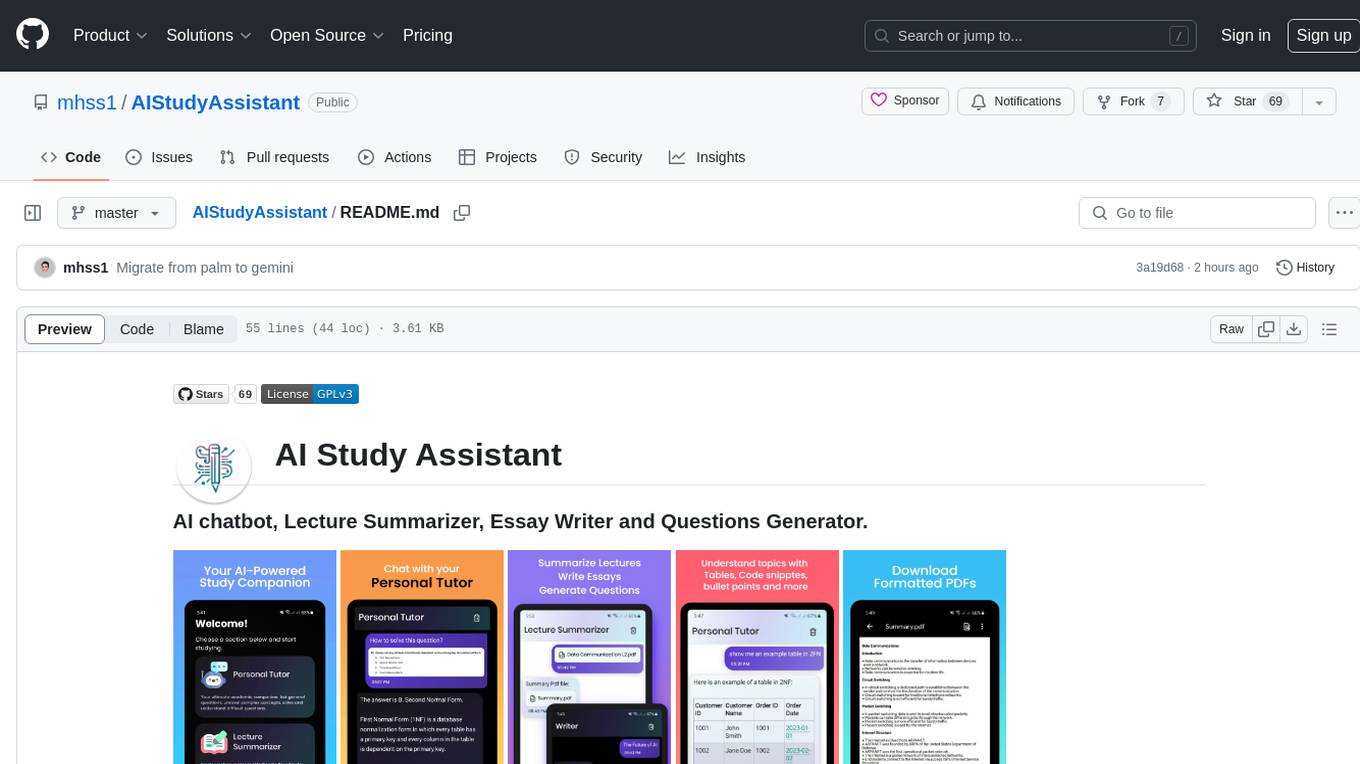
AIStudyAssistant
AI Study Assistant is an app designed to enhance learning experience and boost academic performance. It serves as a personal tutor, lecture summarizer, writer, and question generator powered by Google PaLM 2. Features include interacting with an AI chatbot, summarizing lectures, generating essays, and creating practice questions. The app is built using 100% Kotlin, Jetpack Compose, Clean Architecture, and MVVM design pattern, with technologies like Ktor, Room DB, Hilt, and Kotlin coroutines. AI Study Assistant aims to provide comprehensive AI-powered assistance for students in various academic tasks.
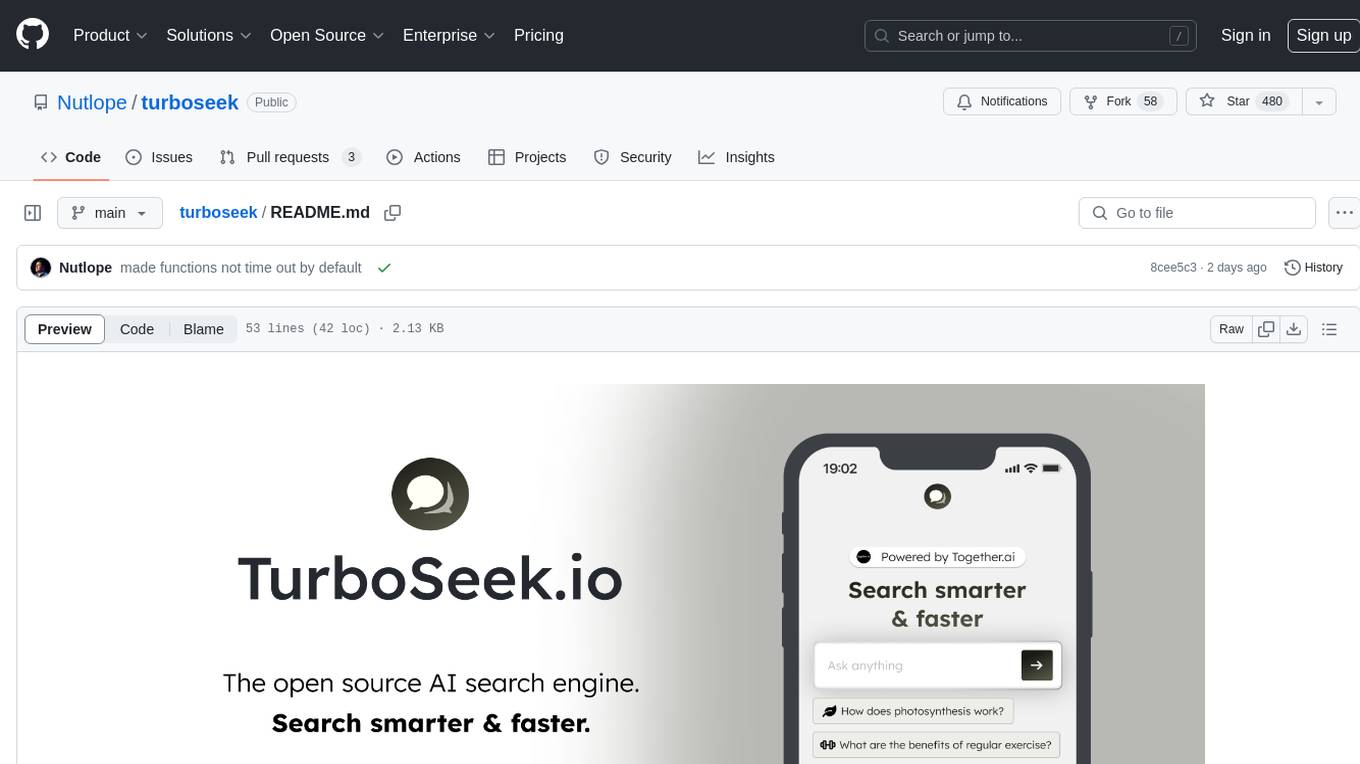
turboseek
TurboSeek is an open source AI search engine powered by Together.ai. It utilizes Next.js with Tailwind for the app router, Together AI for LLM inference, Mixtral 8x7B & Llama-3 for the LLMs, Bing for the search API, Helicone for observability, and Plausible for website analytics. The tool takes a user's question, queries the Bing search API for top results, scrapes text from the links, sends the question and context to Mixtral-8x7B, and generates follow-up questions using Llama-3-8B. Future tasks include optimizing source parsing, ignoring video links, adding regeneration option, ensuring proper citations, enabling sharing, implementing scrolling during answers, fixing hard refresh, adding caching with upstash redis, incorporating advanced RAG techniques, and adding authentication with Clerk and postgres/prisma.
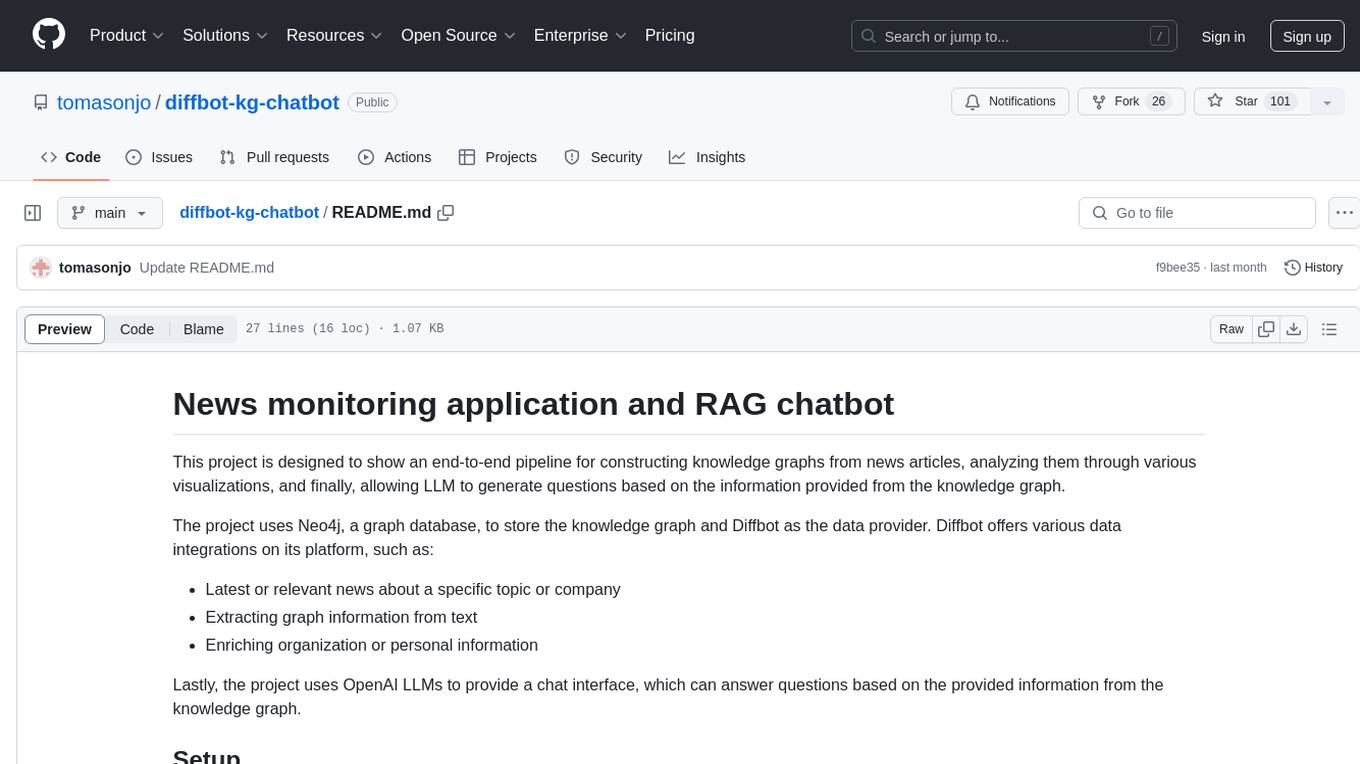
diffbot-kg-chatbot
This project is an end-to-end pipeline for constructing knowledge graphs from news articles using Neo4j and Diffbot. It also utilizes OpenAI LLMs to generate questions based on the knowledge graph. The application offers news monitoring capabilities, data extraction from text, and organization/personal information enrichment. Users can interact with the chatbot interface to ask questions and receive answers based on the knowledge graph.
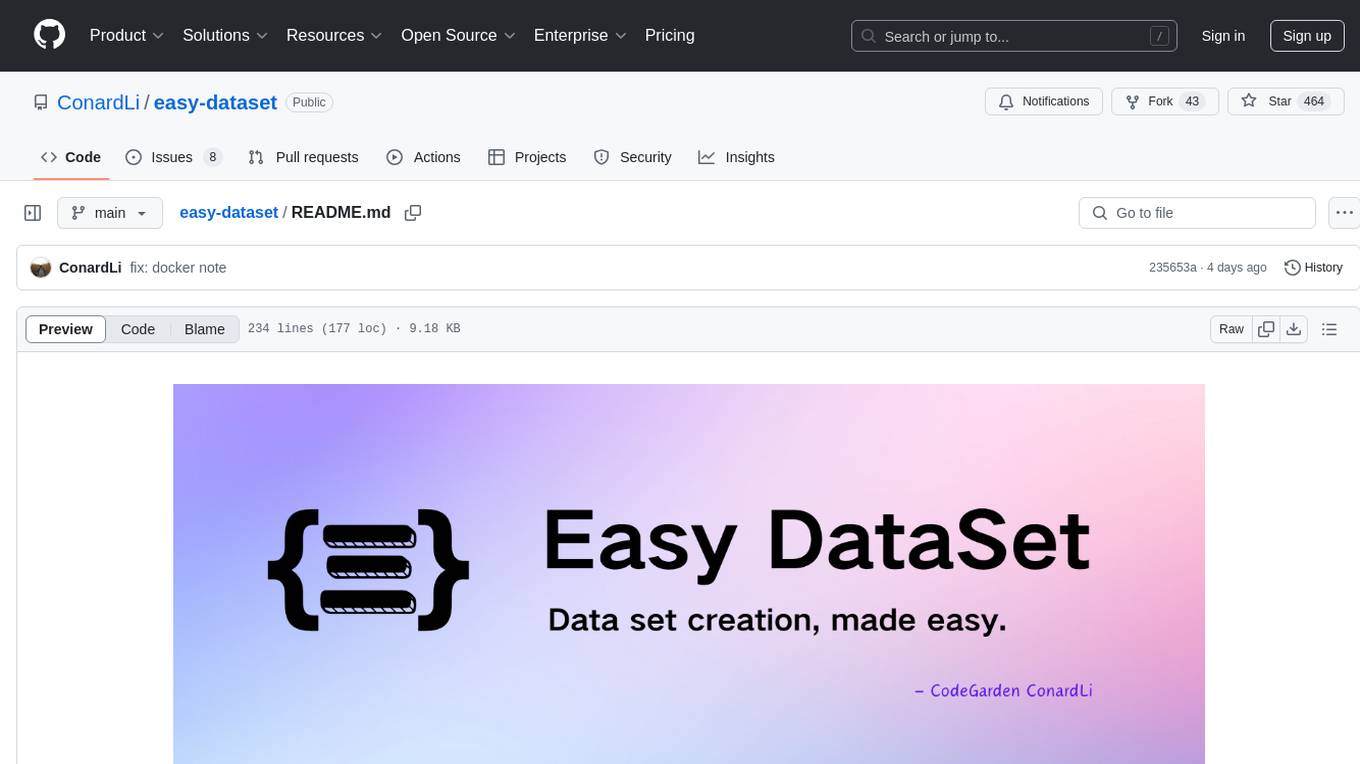
easy-dataset
Easy Dataset is a specialized application designed to streamline the creation of fine-tuning datasets for Large Language Models (LLMs). It offers an intuitive interface for uploading domain-specific files, intelligently splitting content, generating questions, and producing high-quality training data for model fine-tuning. With Easy Dataset, users can transform domain knowledge into structured datasets compatible with all OpenAI-format compatible LLM APIs, making the fine-tuning process accessible and efficient.
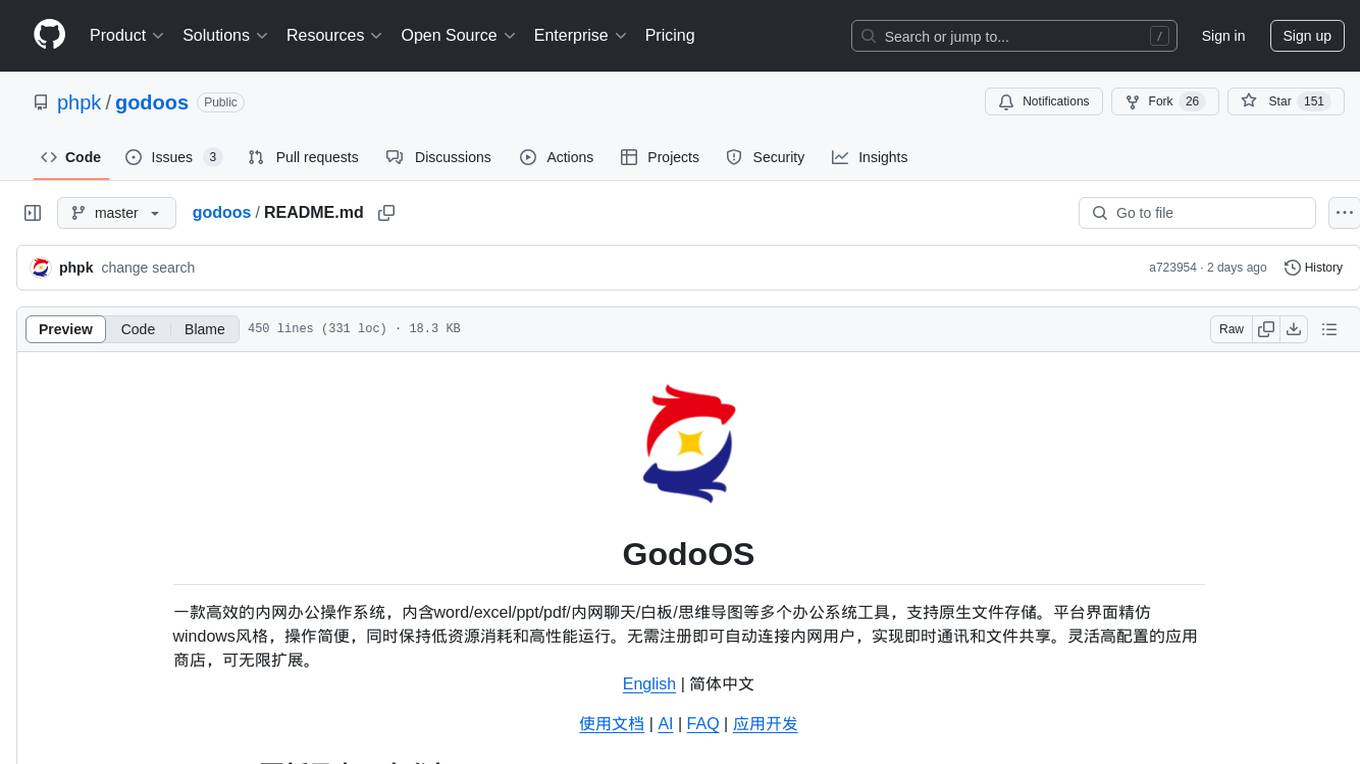
godoos
GodoOS is an efficient intranet office operating system that includes various office tools such as word/excel/ppt/pdf/internal chat/whiteboard/mind map, with native file storage support. The platform interface mimics the Windows style, making it easy to operate while maintaining low resource consumption and high performance. It automatically connects to intranet users without registration, enabling instant communication and file sharing. The flexible and highly configurable app store allows for unlimited expansion.
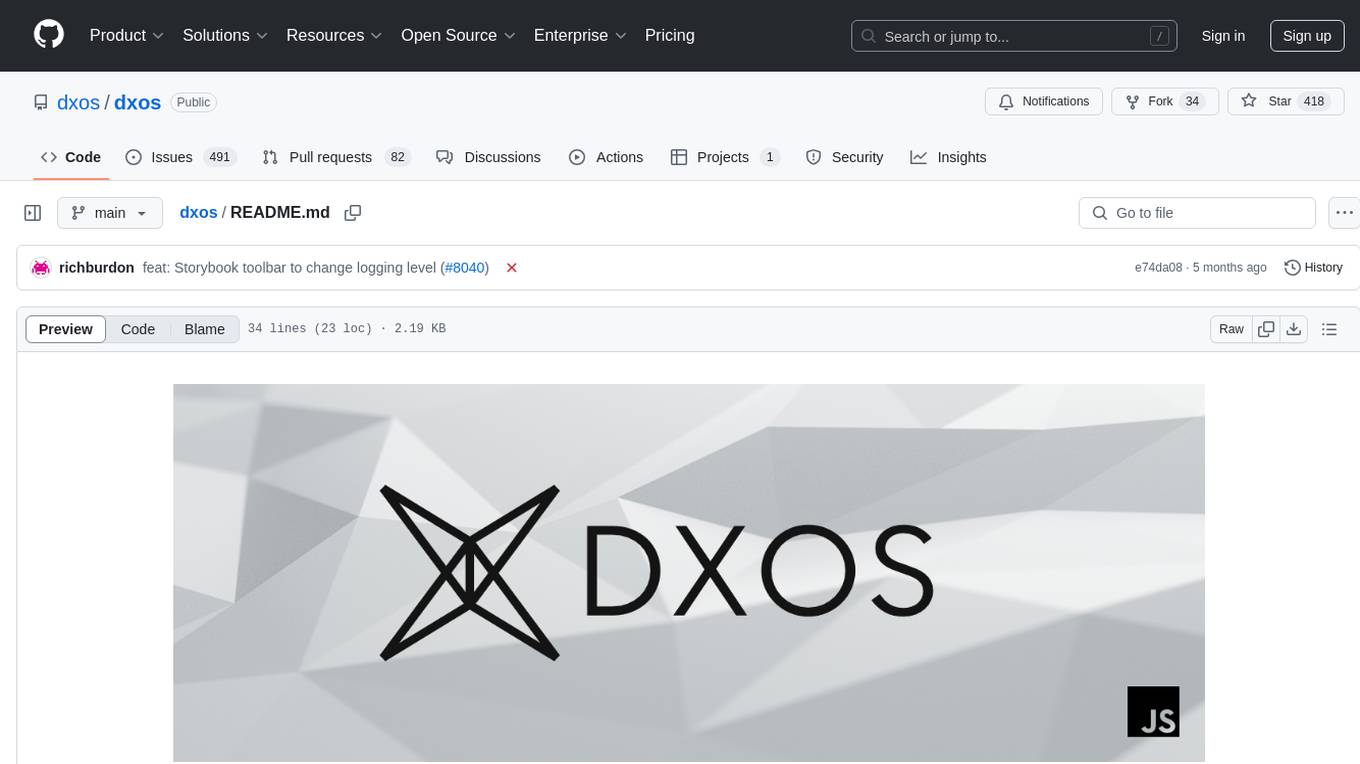
dxos
DXOS is an open-source platform that offers Composer, an extensible app platform for developers to organize and sync their knowledge across devices. It enables real-time or offline collaboration with others, emphasizing a local-first and private approach. The DXOS SDK facilitates peer-to-peer collaboration for local-first apps without relying on central sync servers.
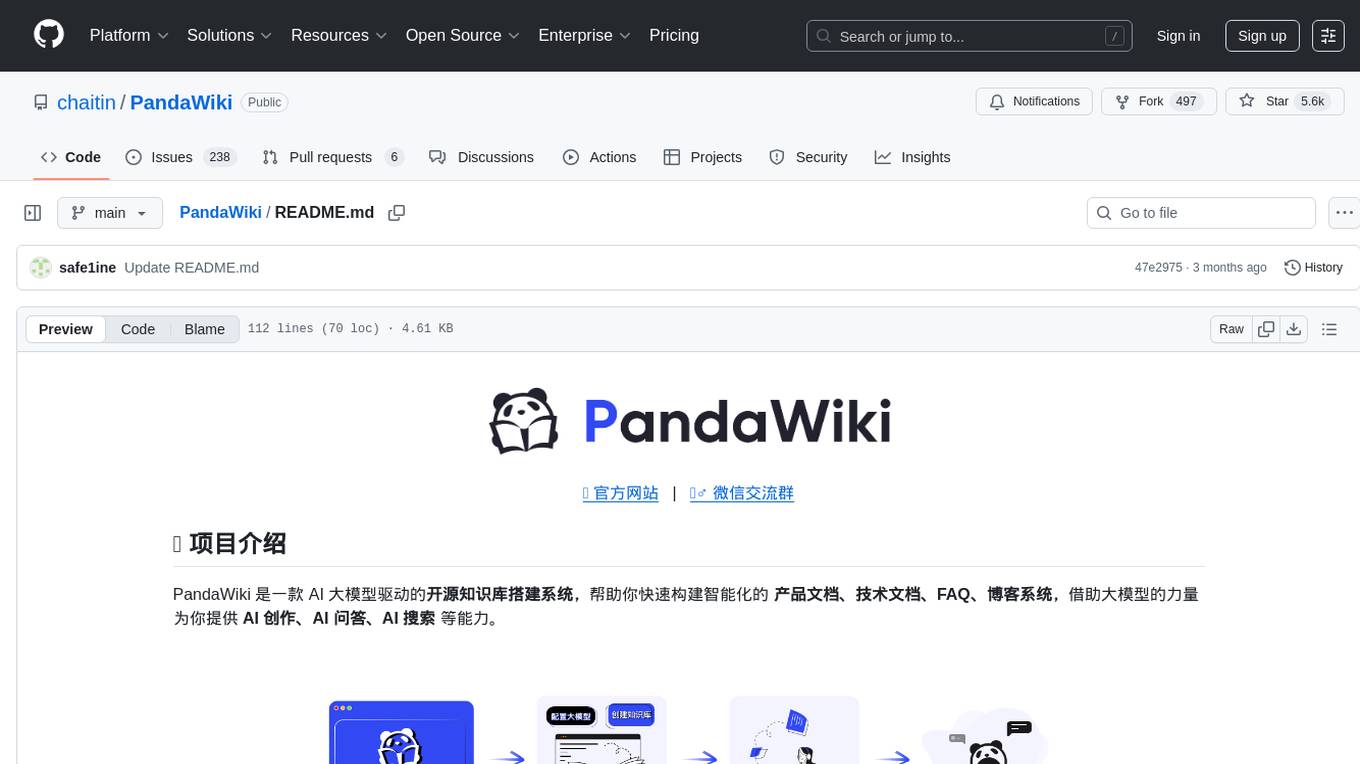
PandaWiki
PandaWiki is a collaborative platform for creating and editing wiki pages. It allows users to easily collaborate on documentation, knowledge sharing, and information dissemination. With features like version control, user permissions, and rich text editing, PandaWiki simplifies the process of creating and managing wiki content. Whether you are working on a team project, organizing information for personal use, or building a knowledge base for your organization, PandaWiki provides a user-friendly and efficient solution for creating and maintaining wiki pages.
For similar jobs

weave
Weave is a toolkit for developing Generative AI applications, built by Weights & Biases. With Weave, you can log and debug language model inputs, outputs, and traces; build rigorous, apples-to-apples evaluations for language model use cases; and organize all the information generated across the LLM workflow, from experimentation to evaluations to production. Weave aims to bring rigor, best-practices, and composability to the inherently experimental process of developing Generative AI software, without introducing cognitive overhead.

LLMStack
LLMStack is a no-code platform for building generative AI agents, workflows, and chatbots. It allows users to connect their own data, internal tools, and GPT-powered models without any coding experience. LLMStack can be deployed to the cloud or on-premise and can be accessed via HTTP API or triggered from Slack or Discord.

VisionCraft
The VisionCraft API is a free API for using over 100 different AI models. From images to sound.

kaito
Kaito is an operator that automates the AI/ML inference model deployment in a Kubernetes cluster. It manages large model files using container images, avoids tuning deployment parameters to fit GPU hardware by providing preset configurations, auto-provisions GPU nodes based on model requirements, and hosts large model images in the public Microsoft Container Registry (MCR) if the license allows. Using Kaito, the workflow of onboarding large AI inference models in Kubernetes is largely simplified.

PyRIT
PyRIT is an open access automation framework designed to empower security professionals and ML engineers to red team foundation models and their applications. It automates AI Red Teaming tasks to allow operators to focus on more complicated and time-consuming tasks and can also identify security harms such as misuse (e.g., malware generation, jailbreaking), and privacy harms (e.g., identity theft). The goal is to allow researchers to have a baseline of how well their model and entire inference pipeline is doing against different harm categories and to be able to compare that baseline to future iterations of their model. This allows them to have empirical data on how well their model is doing today, and detect any degradation of performance based on future improvements.

tabby
Tabby is a self-hosted AI coding assistant, offering an open-source and on-premises alternative to GitHub Copilot. It boasts several key features: * Self-contained, with no need for a DBMS or cloud service. * OpenAPI interface, easy to integrate with existing infrastructure (e.g Cloud IDE). * Supports consumer-grade GPUs.

spear
SPEAR (Simulator for Photorealistic Embodied AI Research) is a powerful tool for training embodied agents. It features 300 unique virtual indoor environments with 2,566 unique rooms and 17,234 unique objects that can be manipulated individually. Each environment is designed by a professional artist and features detailed geometry, photorealistic materials, and a unique floor plan and object layout. SPEAR is implemented as Unreal Engine assets and provides an OpenAI Gym interface for interacting with the environments via Python.

Magick
Magick is a groundbreaking visual AIDE (Artificial Intelligence Development Environment) for no-code data pipelines and multimodal agents. Magick can connect to other services and comes with nodes and templates well-suited for intelligent agents, chatbots, complex reasoning systems and realistic characters.



